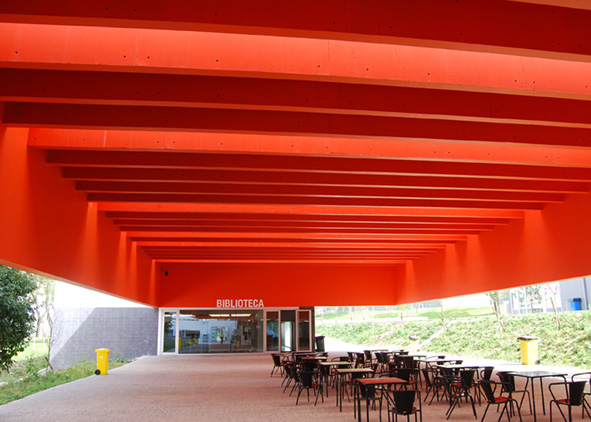Individual and collective scale in the complexity of school space. The Portuguese experience
DOI:
https://doi.org/10.19229/2464-9309/7122020Keywords:
school architecture, rehabilitation, methodology, complexity, multiscaleAbstract
The conception of the contemporary scholar space requires a whole set of aspects that confront opposite scales, by increasing the complexity of achieving systemic, balanced and, most important, clear results. To both fulfil the most recent pedagogical ideals, the functional needs, the social aspirations, and the incorporation of the (new) legal demands, bearing in mind the public investment restraining policy, it becomes a challenge even bigger, from which the political responsibility cannot stand apart. So, through the intervention developed by Parque Escolar on the grounds of rehabilitation of the scholar buildings in Portugal, it’s important to comprehend the dialogue between different scales from distinct environments (programmatic, educational, social and infrastructural), defending this operation as a paradigmatic response to the multi-scale complexity.
Downloads
Article Metrics Graph
References
Almeida, R., Blyth, A., Forrester, D., Gorey, A. and Hostens, G. (2009), OECD/CELE Review of the Secondary School – Modernisation Programme in Portugal. [Online] Available at: www.oecd.org/portugal/44247100.pdf [Accessed 16 March 2020].
Heitor, T. (2011), “Programa de Modernização do Parque Escolar destinado ao Ensino Secundário | Public Secondary Schools Modernization Programme”, in Parque Escolar 2007-2011 – Intervenção em 106 escolas, Parque Escolar – E.P.E., Lisboa, pp. 9-26. [Online] Available at: www.parque-escolar.pt/pt/programa/livros-parque-escolar.aspx [Accessed 15 March 2020].
Heitor, T. (2009), “Modernizar as escolas do ensino secundário”, in Pimenta, J. (ed.), Escolas Secundárias – Reabilitação | Secondary Schools – Rehabilitation, Caleidoscópio Edição e Artes Gráficas, Casal de Cambra, pp. 17-21.
Heitor, T. (2008), “Modernising Portugal’s Secondary Schools”, in PEB Exchange – Programme on Educational Building, n. 2008/01. [Online] Available at: doi.org/10.1787/245552515225 [Accessed 22 March 2020].
Heitor, T. and Marques Pinto, R. (2012), “Thinking Critically Towards Excellence in School Buildings”, in Greene, M., Reyes, J., and Castro A. (eds), Using Space Syntax as a Catalyst for Change: Proceedings of the Eighth International Space Syntax Symposium, Pontificia Universidad Católica de Chile, Santiago, Chile, January 3-6, 2012, PUC, Santiago de Chile, pp. 8018:1-8018:18. [Online] Available at: sss8.cl/8018.pdf [Accessed 14 March 2020].
Kazimirko, A. and Santos, A. (2020), “School spaces in the incorporation of (new) infrastructural needs”, in Book of Abstracts – 13th Meeting of Young Researchers of University of Porto | Livro de Resumos do 13.º Encontro de Jovens Investigadores da U.PORTO, Universidade do Porto, Porto, p. 221. [Online] Available at: ijup.up.pt/2020/wp-content/uploads/sites/464/2020/02/IJUP2020_LivroResumos.pdf [Accessed 14 March 2020].
Ladiana, D. and Lopes, N. L. (2018), “Scenari di Innovazione del Progetto | Cenários de Inovação para o Projeto”, in Ladiana, D., Lopes, N. L. and Afonso, R. B. (eds), A escola ideal, CIAMH – Centro de Inovação em Arquitetura e Modos de Habitar, Porto, pp. 12-24. [Online] Available at: www.academia.edu/39101331/A_ESCOLA_IDEAL [Accessed 14 March 2020].
Ministério da Educação (2007), “Decreto-Lei n. 41/2007”, in Diário da República, n. 37, Série I de 21 de fevereiro de 2007, pp. 1287-1294. [Online] Available at: dre.pt/web/guest/pesquisa/-/search/517859/details/maximized [Accessed 15 March 2020].
Ministério da Educação (2006), “Despacho n. 7503/06”, in Diário da República, n. 67, Série II de 4 de abril de 2006, pp. 5049-5050. [Online] Available at: www.parque-escolar.pt/docs/empresa/legislacao/legislacao-despacho-7503-2006.pdf [Accessed 14 March 2020].
Monteiro, C. and Santos, A. (2020), “School buildings rehabilitation and its’ patrimonial value”, in Book of Abstracts – 13th Meeting of Young Researchers of University of Porto | Livro de Resumos do 13.º Encontro de Jovens Investigadores da U.PORTO, Universidade do Porto, Porto, p. 106. [Online] Available at: ijup.up.pt/2020/wp-content/uploads/sites/464/2020/02/IJUP2020_LivroResumos.pdf [Accessed 14 March 2020].
Montoan, M. T. E. (2003), Inclusão Escolar – O que é? Por quê? Como fazer?, Moderna, São Paulo. [Online] Available at: files.cercomp.ufg.br/weby/up/211/o/INCLUS%C3%83O-ESCOLARMaria-Teresa-Egl%C3%A9r-Mantoan-Inclus%C3%A3o-Escolar.pdf?1473202907 [Accessed 18 March 2020].
OECD – Organization for Economic Co-operation and Development (2006), Evaluating Quality in Educational Facilities, OECD Publishing. Available at: www.oecd-ilibrary.org/education/evaluating-quality-in-educational-facilities_530661814151 [Accessed 28 April 2020].
Parque Escolar – E.P.E. (2012), “Desqualificação física, construtiva e funcional do parque escolar nacional – Documento n. 1”, in Tribunal de Contas, Auditoria orientada ao Programa de Modernização do Parque Escolar destinada ao Ensino Secundário, 2007 a 2010 – Relatório de Auditoria n. 09/12. [Online] Available at: www.tcontas.pt/pt-pt/ProdutosTC/Relatorios/RelatoriosAuditoria/Documents/2012/rel009-2012-2s.pdf [Accessed 18 March 2020].
Santos, A. and Monteiro, C. (2019), “Reabilitação do Património Escolar – Expressão Pedagógica, Multidisciplinary e Multicultural”, in Tavares, A. and Costa, A. (eds), 6.º Fórum Internacional do Património Arquitetónico Portugal/Brasil, Universidade de Aveiro, Aveiro, pp. 122-123. [Online] Available at: www.researchgate.net/publication/334225418_Forum_Internacional_ Patrimonio_Arquitetonico_Portugal_Brasil_-2019_6_Edicao [Accessed 14 March 2020].
Taylor, A. (2000), Programming and Design of Schools Within the Context of Community. [Online] Available at: www.designshare.com/Research/Taylor/Taylor_Programming_1.htm [Accessed 10 Marco 2020].
UNESCO (1994), The Salamanca Statement and Framework for Action on Special Needs Education – Adopted by the World Conference on Special Needs Education: Access and Quality, Salamanca, Spain, 7-10 June 1994. [Online] Available at: unesdoc.unesco.org/ark:/48223/pf0000098427?posInSet=1&queryId=f8d42b50-7c80-4568-90c9-23b2a6714540 [Accessed 18 March 2020].

Downloads
Published
How to Cite
Issue
Section
License
This Journal is published under Creative Commons Attribution Licence 4.0 (CC-BY).
License scheme | Legal code
This License allows anyone to:
Share: copy and redistribute the material in any medium or format.
Adapt: remix, transform, and build upon the material for any purpose, even commercially.
Under the following terms
Attribution: Users must give appropriate credit, provide a link to the license, and indicate if changes were made; users may do so in any reasonable manner, but not in any way that suggests the licensor endorses them or their use.
No additional restrictions: Users may not apply legal terms or technological measures that legally restrict others from doing anything the license permits.
Notices
Users do not have to comply with the license for elements of the material in the public domain or where your use is permitted by an applicable exception or limitation.
No warranties are given. The license may not give users all of the permissions necessary for their intended use. For example, other rights such as publicity, privacy, or moral rights may limit how you use the material.


















































































